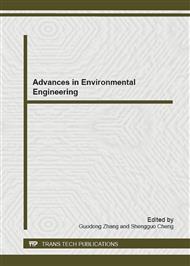[1]
G.Fransolet,G. Villers,A.Goyens,andW. J.Masschelein,"Metabolic identification of germs identified form ozonized water mixed with underground water", Ozone Sci.Vol. 8 (1986),p.95.
DOI: 10.1080/01919518608552287
Google Scholar
[2]
R.I. Amann,W. Ludwig K.H. Schleifer,"Phylogenetic identification and insitu detection of individual microbial cells without cultivation", Microbiol. Rev.Vol. 59(1995),pp.143-169.
DOI: 10.1128/mr.59.1.143-169.1995
Google Scholar
[3]
R.L. Kepner, and J.R. Pratt, "Use of fluorochromes for direct enumeration of total bacteria in environmental sample: past and present", Micro.Rev.Vol58,(1994),pp.603-615.
DOI: 10.1128/mr.58.4.603-615.1994
Google Scholar
[4]
J.Långmark, M.V. Storey, N.J. Ashbolt, and T.A. Stenström, "Accumulation and fate of microorganims and microspheres in biofilms formed in pilot-scale water distribution system. Appl", Environ. Microbiol. Vol71(2)(2005),pp.706-712.
DOI: 10.1128/aem.71.2.706-712.2005
Google Scholar
[5]
P.W. Butterfield, A.K. Camper, B.D. Ellis, and W.L. Jones, "Chlorination of model drinking water biofilm: implications for growth and organic carbon removal", Vol.36, (2002), pp.4391-4405.
DOI: 10.1016/s0043-1354(02)00148-3
Google Scholar
[6]
T.L. Hu and Y.H. Cai "Quantitative Fluorescent In Situ Hybridization of biofilms in drinking water distribution System", 27th waterwater treatment technology in Taiwan, (2002)(in Chiness).
Google Scholar
[7]
S.D. Richardson, A.D. Thruston Jr, T.W. Collette, K.S. Patterson, B.V. Lykins Jr, G.Majetich, and Y.Zhang, "Multispectral identification of chlorine dioxide disinfection byproductsin drinking water", Environ Sci Technol. Vol.28(4), (1994), pp.592-599.
DOI: 10.1021/es00053a010
Google Scholar
[8]
S.D. Richardson, "Drinking water disinfection by-products. In: Mey RA, editor. The encyclopedia of environmental analysis and remediation", New York: Wiley, (1998), pp.1398-421.
Google Scholar
[9]
A. Camper, K. Brastrp, A. Sandvig, J. Clement, C. Spencer, and A. J. Capuzzi, "Effect of distribution system materials on bacterial regrowth", Jour. AWWA. Vol. 95(7), (2003), pp.107-121.
DOI: 10.1002/j.1551-8833.2003.tb10412.x
Google Scholar
[10]
Y. P. Tsai, "Simulation of biofilm formation at different assimilable organic carbon concentrations under lower flow velocity condition", J. Basic Microbiol., Vol. 45, (2005),pp.475-485.
DOI: 10.1002/jobm.200510583
Google Scholar
[11]
J.M. Cappelier, B.Lazaro, A.Rossero, A. Femandez-Astorga, and M. Federighi, "double staining (CTC-DAPI) for detection and ceumeration of viable but non-culturable Campylobacter jejuni cells", Wat. Res. Vol. 28, (1997), pp.547-555.
DOI: 10.1006/fmic.2000.0366
Google Scholar
[12]
G. Schaule, H. C.Flemming, and H. F. Ridgway, "Use of 5-Cyano-2,3-Ditolyl Tetrazolium Chloride for quantifying planktonic and sessile respiring bacteria in drinking water", Appl. Environ. Microbiol. Vol. 59(11), (1993),pp.3850-3857.
DOI: 10.1128/aem.59.11.3850-3857.1993
Google Scholar
[13]
G. A. Gagnona, and R. M. Slawsonb, "An efficient biofilm removal method for bacterial cells exposed to drinking water", J. Microbiol. Methods,Vol. 34, (1999), p.203–214.
DOI: 10.1016/s0167-7012(98)00089-x
Google Scholar
[14]
B.M. Yang"Effect of disinfection on the bioactivity of biofilm", master thesis in Tajen University (1996)(in Chiness)
Google Scholar
[15]
G. G. Rodriguez, D. Phipps, K. Ishiguro, and H. Ridgway, "Use of a fluorescent redox probe for direct visualization of actively respiring bacteria", Appl. Environ. Microbiol,Vol. 58(6), (1992),pp.1801-1808.
DOI: 10.1128/aem.58.6.1801-1808.1992
Google Scholar
[16]
F. P. Yu, and A. McFeters, "Rapid in situ assessment of physiological activities in bacterial biofilm using fluoresecent probes", Microbiol. Methods,Vol. 20, (1994), pp.1-10.
Google Scholar
[17]
C. T.Huang, F. P. Yu, G. A. Mcfeters, and P. S. Stewart, "Nonuniform spatial patterns of respiratory activity within biofilms during disinfection". Appl. Envir. Microbiol,Vol. 61(6), (1995),pp.2252-2256.
DOI: 10.1128/aem.61.6.2252-2256.1995
Google Scholar
[18]
E. Van der Wende, W. G. Characklis, and D. B. Smith, "Biofilm and bacterial drinking water quality", Wat. Res. Vol. 23, (1989),pp.1313-1322.
DOI: 10.1016/0043-1354(89)90193-0
Google Scholar
[19]
N. B. Hallam, J. R. West, C. F. Forster, and J. Simms, "The poten for biofilm growth in water distribution systems", Wat. Res,Vol. 35(17), (2001),pp.4063-4071.
DOI: 10.1016/s0043-1354(01)00248-2
Google Scholar


